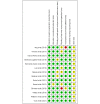The Efficacy and Safety of Telerehabilitation for Fibromyalgia: Systematic Review and Meta-analysis of Randomized Controlled Trials
- PMID: 37097721
- PMCID: PMC10170363
- DOI: 10.2196/42090
The Efficacy and Safety of Telerehabilitation for Fibromyalgia: Systematic Review and Meta-analysis of Randomized Controlled Trials
Abstract
Background: Fibromyalgia is a chronic pain syndrome characterized by persistent and widespread musculoskeletal pain. Telerehabilitation is a promising treatment for patients with fibromyalgia through long-term monitoring, intervention, supervision, consultation, and education.
Objective: This study aimed to perform a comprehensive systematic review and meta-analysis of the efficacy and safety of telerehabilitation in patients with fibromyalgia.
Methods: Randomized controlled trials (RCTs) related to fibromyalgia and telerehabilitation were systematically searched in the PubMed, PEDro, Cochrane Library, ScienceDirect, Ovid MEDLINE, Embase, and Web of Science databases from inception to November 13, 2022. Two independent researchers screened the literatures and evaluated the methodological quality using the Cochrane Risk of Bias Tool. The outcome measures included the Fibromyalgia Impact Questionnaire scale, pain intensity, depression, pain catastrophizing, quality of life (QoL), and adverse events. Pooled effect sizes were calculated by Stata SE 15.1; a fixed effects model was used when I2<50%, whereas a random effects model was used when I2≥50%.
Results: A total of 14 RCTs with 1242 participants were included in this meta-analysis. The pooled results indicated that the telerehabilitation improved the Fibromyalgia Impact Questionnaire score (weighted mean difference -8.32, 95% CI -11.72 to -4.91; P<.001), pain intensity (standardized mean difference [SMD] -0.62, 95% CI -0.76 to -0.47; P<.001), depression levels (SMD -0.42, 95% CI -0.62 to -0.22; P<.001), pain catastrophizing (weighted mean difference -5.81, 95% CI -9.40 to -2.23; P=.001), and QoL (SMD 0.32, 95% CI 0.18 to 0.47; P<.001) in patients with fibromyalgia compared to control interventions. Only 1 RCT reported a mild adverse event of telerehabilitation; the other 13 RCTs did not mention this.
Conclusions: Telerehabilitation can improve the symptoms and QoL of fibromyalgia. However, the safety of telerehabilitation remains uncertain due to the lack of sufficient evidence for the management of fibromyalgia. More rigorously designed trials are needed in the future to verify the safety and efficacy of telerehabilitation in fibromyalgia.
Trial registration: PROSPERO CRD42022338200; https://tinyurl.com/322keukv.
Keywords: chronic pain; consultation; education; efficacy; fibromyalgia; intervention; meta-analysis; monitoring; musculoskeletal; pain; rehabilitation; safety; systematic review; telerehabilitation.
©Yong-Qiang Wu, Yi Long, Wei-Jie Peng, Cheng Gong, Yue-Quan Liu, Xu-Miao Peng, Yan-Biao Zhong, Yun Luo, Mao-Yuan Wang. Originally published in the Journal of Medical Internet Research (https://www.jmir.org), 25.04.2023.
Conflict of interest statement
Conflicts of Interest: None declared.
Figures








References
-
- Giorgi V, Sirotti S, Romano ME, Marotto D, Ablin JN, Salaffi F, Sarzi-Puttini P. Fibromyalgia: one year in review 2022. Clin Exp Rheumatol. 2022 Jun;40(6):1065–1072. doi: 10.55563/clinexprheumatol/if9gk2. https://www.clinexprheumatol.org/pubmed/find-pii.asp?pii=35748720 18644 - DOI - PubMed
-
- Kim SY, Busch AJ, Overend TJ, Schachter CL, van der Spuy I, Boden C, Góes Suelen M, Foulds HJ, Bidonde J. Flexibility exercise training for adults with fibromyalgia. Cochrane Database Syst Rev. 2019 Sep 02;9(9):CD013419. doi: 10.1002/14651858.CD013419. https://europepmc.org/abstract/MED/31476271 - DOI - PMC - PubMed
Publication types
MeSH terms
LinkOut - more resources
Full Text Sources
Medical

